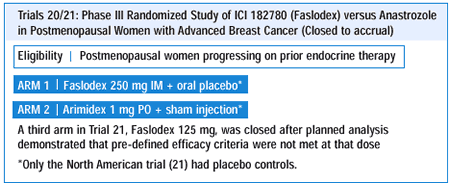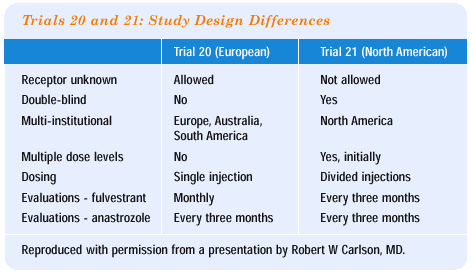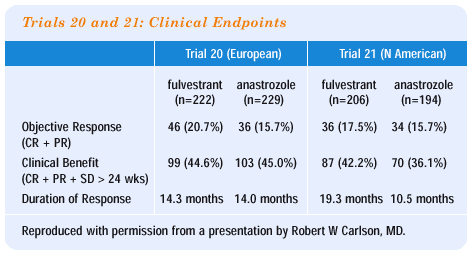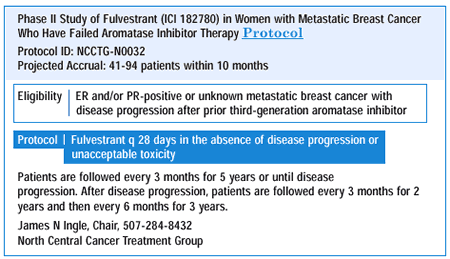| You are here: Home: BCU 1|2002: Robert W Carlson, MD

Edited Comments by Dr Carlson
ESTROGEN RECEPTOR DOWNREGULATOR: MECHANISM OF ACTION
The new class of hormonal agents known as estrogen receptor downregulators has a fundamentally different interaction with the breast cancer cell than other hormonal agents. These agents occupy the estrogen receptor and inhibit dimerization of the receptor and both activation functions 1 and 2, causing estrogen receptor downregulation. The estrogen receptor is unable to interact with the estrogen response element in the nucleus, causing a complete failure of transcription.
CLINICAL TRIALS OF FULVESTRANT VERSUS ANASTROZOLE
The results of the European and North American trials of fulvestrant in postmenopausal women with hormone-responsive metastatic breast cancer are quite consistent and demonstrate a similar time to progression compared to anastrozole. The data suggest that fulvestrant is at least as active as anastrozole, and the North American trial suggests that it is more active.
The superiority in duration of response in the North American trial, however, was not observed in the European trial. It remains to be seen whether that is because there really is no superiority or because of methodological differences between the trials.
In the North American trial, a monthly fulvestrant placebo injection was given to anastrozole-treated women, and an anastrozole placebo was given to fulvestrant-treated women. While the women received injections every month, their period of evaluation for time to progression was every three months. In this study, the duration of response was almost twice as long with fulvestrant as with anastrozole.
In contrast, women in the European trial got their monthly fulvestrant injections in an unblinded fashion, and patients randomized to anastrozole were evaluated every three months.
We would expect to see a shorter time to progression in the fulvestrant arm, even if the two therapies were absolutely equivalent, because monthly evaluations give many more opportunities to see evidence of progressive disease. Based on the mechanism of action and pre-clinical data, I would expect fulvestrant to have superior clinical activity, but randomized trials are necessary to confirm that optimism.



SEQUENCING OF FULVESTRANT
Estrogen receptor-positive cells exposed to fulvestrant actually lose estrogen receptors on immunohistochemistry — a true estrogen receptor downregulation. This has caused concern that breast cancers treated with fulvestrant may become refractory to subsequent hormonal therapies. As a result, sequencing of fulvestrant in relation to the other hormonal therapies is one of the uncertainties we have. In limited studies of patients treated with fulvestrant followed by one of the selective nonsteroidal aromatase inhibitors or megestrol acetate, objective responses were in the range of 20 percent — about what we would expect for a third-line hormonal therapy. In addition, in preclinical systems, recent data suggest that the estrogen receptor does reappear in the cells after fulvestrant is withdrawn. So, some of the concerns about the tumor evolving into a hormone refractory state appear to be unfounded.

ADVANTAGES OF FULVESTRANT
While estrogen receptor modulators stimulate the endometrium and are associated with low frequencies of endometrial carcinoma, it appears that estrogen receptor downregulators will not have that stimulatory effect. Although the monthly intramuscular injection can be viewed as a disadvantage of fulvestrant, it can also be viewed as an advantage, because you can assure compliance. In addition, fulvestrant doesn't cross the blood-brain barrier, so there is hope that there will be fewer hot flashes than with the selective estrogen receptor modulators. In the comparative trials with anastrozole, the occurrence of hot flashes was in the range of about 20 percent in both treatment groups.
Page 1 of 3
Next Page
|
